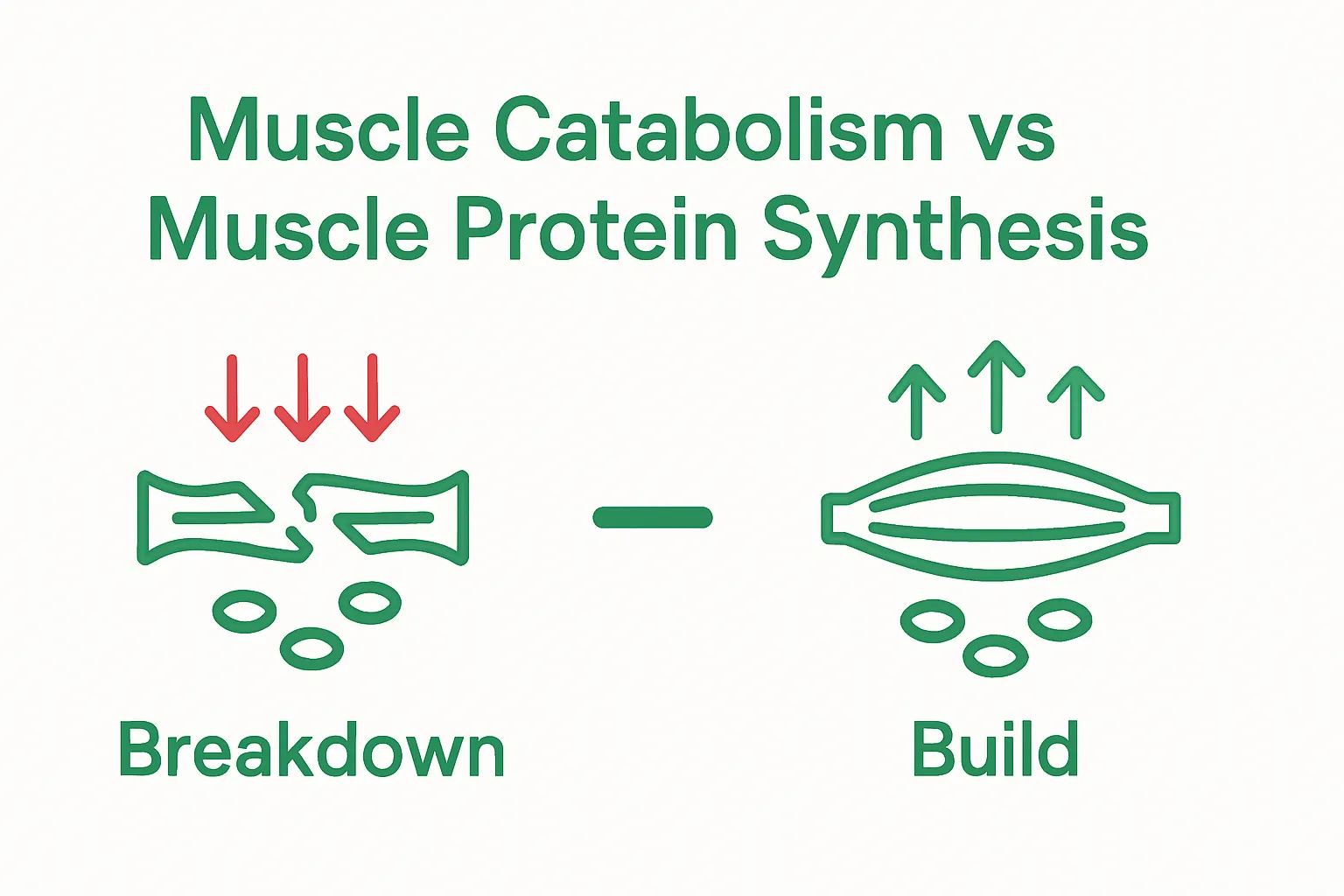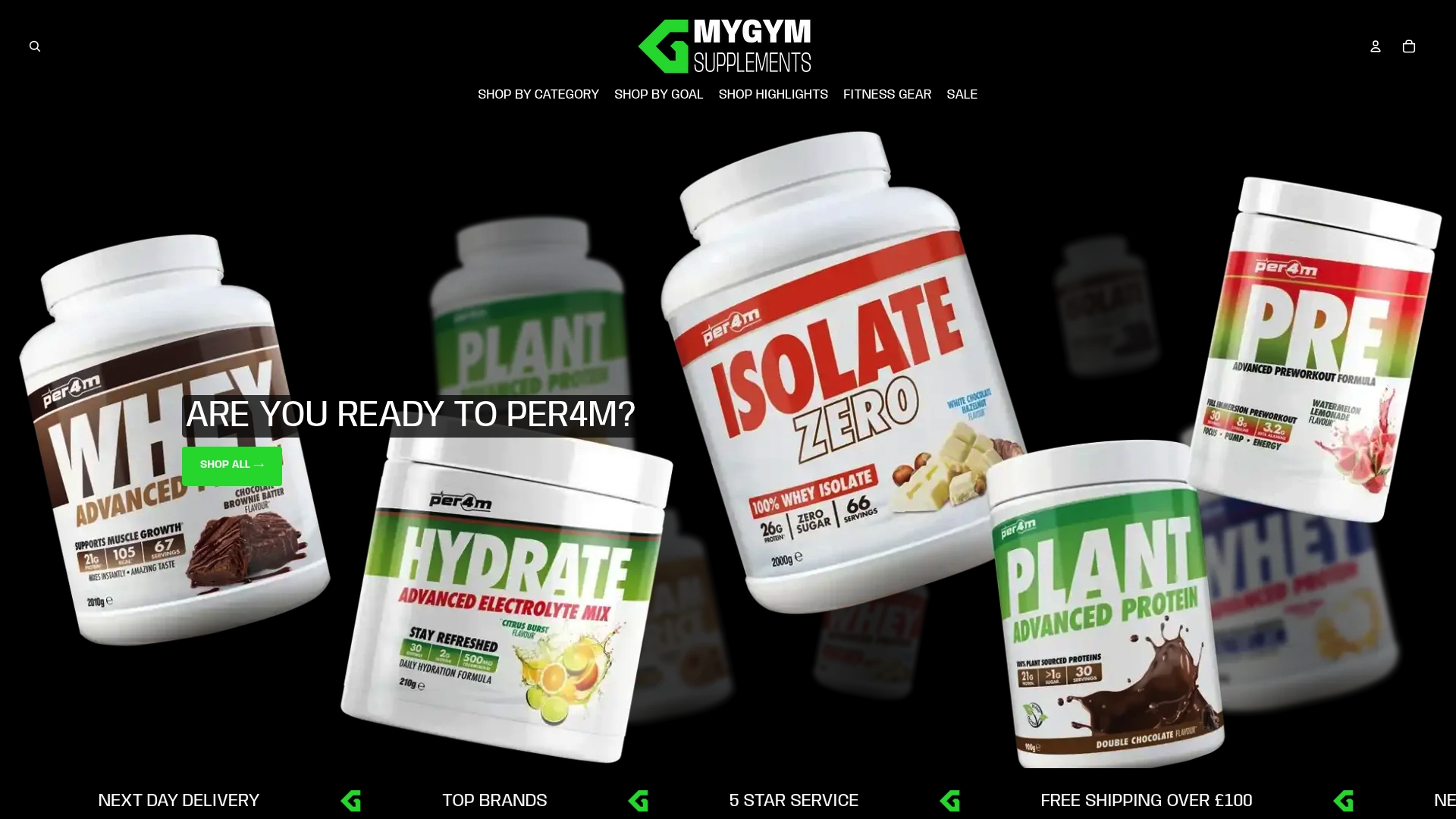Muscle catabolism might sound like something every athlete and gym-goer wants to avoid but it is far more common than most people think. Surprise awaits. A single intense workout session can trigger significant muscle protein breakdown within hours if nutrition is neglected. Instead of being a straightforward enemy to muscle gains, this process actually helps your muscles renew and adapt in surprising ways.
Table of Contents
- Defining Muscle Catabolism: The Basics
- The Importance Of Muscle Catabolism In Fitness
- How Muscle Catabolism Occurs: The Biological Process
- Factors Influencing Muscle Catabolism
- The Effects Of Muscle Catabolism On Performance And Recovery
Quick Summary
| Takeaway | Explanation |
|---|---|
| Understand muscle catabolism’s role | Muscle catabolism, while often viewed negatively, is essential for energy production and muscle adaptation during exercise. |
| Control triggers to minimise breakdown | Factors like intense exercise, poor nutrition, and stress can accelerate muscle catabolism, so managing these is crucial for muscle health. |
| Nutritional intake affects catabolism | Inadequate protein and caloric intake heighten muscle breakdown, making balanced nutrition vital for muscle preservation. |
| Hormones influence catabolic processes | Elevated cortisol and low testosterone levels can enhance muscle catabolism, so monitoring hormone levels can help prevent excessive breakdown. |
| Use catabolism for recovery benefits | Controlled muscle breakdown during recovery can promote better repair and growth, leading to improved strength and performance. |
Defining Muscle Catabolism: The Basics
Muscle catabolism represents a fundamental metabolic process where muscle tissue breaks down, releasing amino acids that can be used for energy production or other physiological requirements. Understanding this process is crucial for athletes, fitness enthusiasts, and individuals concerned with muscle health and performance.
What Exactly is Muscle Catabolism?
At its core, muscle catabolism describes the biochemical breakdown of muscle proteins into smaller amino acid components. Scientific research from the National Institutes of Health confirms this process occurs naturally in the body as part of normal metabolic functioning. Unlike muscle protein synthesis which builds muscle tissue, catabolism involves the degradation of muscle protein structures.
To help clarify the distinct roles and outcomes, the following table compares muscle catabolism and muscle protein synthesis as discussed throughout the article.
| Process | Description | Physiological Function | Role in Fitness |
|---|---|---|---|
| Muscle Catabolism | Breakdown of muscle proteins into amino acids | Releases amino acids for energy and repair | Enables adaptation and renewal |
| Muscle Protein Synthesis | Building of new muscle proteins from amino acids | Repairs and builds muscle tissue | Promotes growth and preservation |

Key characteristics of muscle catabolism include:
- Breaking down complex muscle protein molecules
- Releasing individual amino acids into the bloodstream
- Potentially using these amino acids for alternative energy production
Triggers and Mechanisms of Muscle Breakdown
Several physiological conditions can accelerate muscle catabolism. Prolonged intense exercise, severe caloric restriction, chronic stress, inadequate protein intake, and certain medical conditions can all contribute to increased muscle tissue breakdown. The body initiates this process when it requires additional energy sources or when muscle proteins are not being actively maintained through proper nutrition and exercise.
Hormonal responses play a significant role in muscle catabolism. Cortisol, often called the “stress hormone”, can significantly increase muscle protein breakdown when elevated for extended periods. Similarly, insufficient testosterone and growth hormone levels can create an environment more conducive to muscle tissue degradation.
Explore our guide on muscle protein synthesis to understand the complementary process that helps counteract muscle breakdown and supports muscle preservation.
The Importance of Muscle Catabolism in Fitness
While muscle catabolism is often perceived negatively, it plays a critical role in fitness, athletic performance, and overall physiological adaptation. Understanding its nuanced function helps athletes and fitness enthusiasts develop more sophisticated training and nutritional strategies.
Muscle Adaptation and Performance Optimization
Scientific research from the Journal of Sports Sciences reveals that muscle catabolism is not merely a destructive process but a sophisticated mechanism for cellular renewal and adaptation. During intense physical training, controlled muscle protein breakdown enables the body to remove damaged protein structures, creating space for more efficient muscle reconstruction.
Key benefits of strategic muscle catabolism include:
- Removing damaged or inefficient muscle proteins
- Stimulating muscle protein synthesis
- Enhancing overall muscle quality and performance
Metabolic Signalling and Cellular Repair
Muscle catabolism acts as a critical signalling mechanism in the body’s adaptive responses. When muscle tissues experience stress through exercise, the breakdown process triggers important repair and growth mechanisms. This process, known as hormesis, allows muscles to become stronger and more resilient through controlled breakdown and subsequent reconstruction.
Hormonal responses during muscle catabolism activate satellite cells, specialised muscle stem cells responsible for muscle repair and growth. These cells are crucial for muscle regeneration, helping athletes recover from intense training and develop increased muscle strength and endurance.
Learn more about lean muscle development to understand how strategic muscle breakdown contributes to long-term fitness goals. By comprehending these intricate physiological processes, athletes can design more effective training protocols that balance muscle breakdown with robust protein synthesis.
How Muscle Catabolism Occurs: The Biological Process
The biological mechanisms of muscle catabolism involve complex molecular interactions that systematically break down muscle proteins, releasing amino acids for alternative metabolic processes. Understanding these intricate pathways provides insights into how the human body manages energy and cellular maintenance.
Proteolytic Enzyme Systems
Research from the National Institutes of Health demonstrates that muscle catabolism primarily occurs through two sophisticated proteolytic enzyme systems: the ubiquitin-proteasome system and the autophagy-lysosome pathway. These molecular machinery systems function as precision tools for protein degradation, selectively targeting damaged or unnecessary muscle proteins.
Key characteristics of these proteolytic systems include:
- Identifying and marking proteins for breakdown
- Efficiently dismantling protein structures
- Recycling amino acids for alternative cellular functions
Hormonal and Metabolic Triggers
Hormonal responses play a crucial role in initiating muscle protein breakdown. Cortisol, glucagon, and adrenaline can significantly accelerate muscle catabolism during periods of metabolic stress, such as prolonged exercise, caloric restriction, or intense physical challenges. These hormones signal the body to prioritise energy conservation by breaking down muscle proteins into amino acids that can be converted into glucose through gluconeogenesis.
The process involves complex interactions between catabolic hormones and cellular signalling mechanisms. When energy demands exceed immediate glucose availability, the body activates protein breakdown pathways to generate essential metabolic substrates. This adaptive mechanism ensures survival by providing alternative energy sources during challenging physiological conditions.
Explore our guide on muscle hypertrophy to understand the complementary process of muscle protein synthesis and how the body maintains a delicate balance between muscle breakdown and reconstruction.
Factors Influencing Muscle Catabolism
Muscle catabolism is not a random process but a carefully regulated metabolic response influenced by multiple physiological and environmental factors. Understanding these variables helps athletes and fitness enthusiasts develop strategies to minimise excessive muscle breakdown and optimise muscle preservation.
Nutritional and Metabolic Determinants
Research published in the Endocrine Society’s Journal demonstrates that nutritional status profoundly impacts muscle protein breakdown. Insufficient protein intake, prolonged caloric restriction, and micronutrient deficiencies can significantly accelerate muscle catabolism, compelling the body to break down muscle tissue for essential amino acids.
Key nutritional factors driving muscle catabolism include:
- Inadequate protein consumption
- Prolonged negative energy balance
- Micronutrient deficiencies
- Imbalanced macronutrient intake
Physiological and Environmental Stressors
External and internal stressors play crucial roles in triggering muscle protein breakdown. Chronic psychological stress, intense physical training, sleep deprivation, and hormonal imbalances can elevate cortisol levels, a primary catabolic hormone that promotes muscle tissue degradation. Extreme environmental conditions such as excessive heat or cold can also induce metabolic stress, potentially increasing muscle catabolism.
Physiological conditions like prolonged illness, injury recovery, and age-related hormonal changes can further accelerate muscle protein breakdown. Individuals experiencing these conditions often require targeted nutritional interventions and strategic exercise protocols to mitigate muscle loss.
The following table summarises key nutritional and physiological factors that influence muscle catabolism, aiding in the identification of areas where intervention could help preserve muscle mass.
| Factor | Impact on Muscle Catabolism | Example/Explanation |
|---|---|---|
| Inadequate Protein Intake | Increases breakdown rate | Muscle tissue provides amino acids for needs |
| Caloric Restriction | Accelerates catabolism | Body uses muscle to meet energy demands |
| Micronutrient Deficiencies | Promotes breakdown | Impairs cellular repair and function |
| Chronic Stress | Raises cortisol, increases breakdown | Long-term elevation harms muscle tissue |
| Hormonal Imbalances | Enhances catabolic environment | Low testosterone, high cortisol |
| Sleep Deprivation | Elevates stress hormones | Disrupts recovery processes |
| Intense Physical Training | Triggers greater muscle breakdown | Especially when nutrition is neglected |

Check our guide on muscle fatigue to understand how physiological stress impacts muscle performance and breakdown mechanisms. By comprehending these intricate interactions, athletes can develop more sophisticated approaches to muscle preservation and performance optimisation.
The Effects of Muscle Catabolism on Performance and Recovery
Muscle catabolism represents a complex physiological process with profound implications for athletic performance, recovery, and overall physical capabilities. Understanding its multifaceted impacts helps athletes and fitness enthusiasts develop more strategic training and nutritional approaches.
Performance Degradation Mechanisms
Scientific research from Sports Medicine reveals that chronic muscle catabolism significantly compromises athletic performance through multiple interconnected pathways. Sustained muscle protein breakdown reduces muscle mass, diminishes strength generation, and impairs overall muscular endurance, creating a cascading effect on physical capabilities.
Key performance impacts of muscle catabolism include:
- Reduced muscle fibre cross-sectional area
- Decreased muscle contractile strength
- Compromised neuromuscular coordination
- Limited energy substrate availability
Recovery and Physiological Adaptation
Muscle catabolism plays a nuanced role in recovery processes, acting simultaneously as a destructive and regenerative mechanism. While protein breakdown might seem counterintuitive, it enables cellular repair by removing damaged protein structures and creating opportunities for more efficient muscle reconstruction. This selective breakdown allows the body to replace inefficient muscle proteins with more resilient alternatives.
During recovery periods, the body initiates complex molecular signalling that balances protein breakdown with protein synthesis. Satellite cell activation and hormonal responses help regenerate muscle tissues, transforming the initial catabolic stress into an adaptive response that ultimately enhances muscular performance and resilience.
Discover our comprehensive guide on muscle protein synthesis to understand how strategic nutritional interventions can optimize the delicate balance between muscle breakdown and reconstruction.
Take Control of Muscle Catabolism With Smart Supplement Choices
Struggling with the risk of muscle breakdown after training hard or during strict diets? If you have learned from our muscle catabolism article that stress, poor nutrition, and intense training can accelerate muscle loss, it is time to move from knowledge to action. Preserving lean muscle and optimising recovery are vital to reaching your fitness goals and protecting your hard-earned strength. Explore high-quality nutritional solutions that directly support your fight against excessive catabolism.

Why wait to lose the gains you have worked so hard for? Visit MyGymSupplements.shop to shop performance-focused protein options, advanced amino acids, and targeted recovery supplements. Discover what fits your routine and act now to maintain muscle health, speed up recovery and unlock your full potential. Shop with confidence and take charge of your muscle performance today.
Frequently Asked Questions
What is muscle catabolism?
Muscle catabolism is the metabolic process where muscle tissue breaks down, releasing amino acids that can be used for energy production or physiological needs.
What causes muscle catabolism to occur?
Muscle catabolism can be triggered by several factors, including prolonged intense exercise, caloric restriction, chronic stress, inadequate protein intake, and certain medical conditions.
How does muscle catabolism affect athletic performance?
Chronic muscle catabolism can reduce muscle mass, strength generation, and overall endurance, compromising athletic performance and physical capabilities.
Is muscle catabolism a necessary process for muscle growth?
Yes, while muscle catabolism may seem detrimental, it plays a critical role in muscle adaptation and recovery, allowing for the removal of damaged proteins and stimulating muscle protein synthesis for growth.
Recommended
- What is Muscle Breakdown? Understanding the Basics and Impacts – MyGymSupplements
- What is Muscle Fatigue? Understanding Its Causes and Effects – MyGymSupplements
- What is Muscle Protein Synthesis? Understanding Its Importance – MyGymSupplements
- What is Lean Muscle? Understanding Its Importance and Function – MyGymSupplements



0 comments